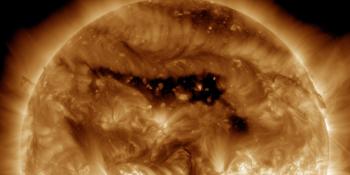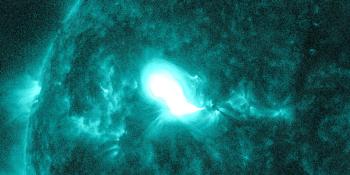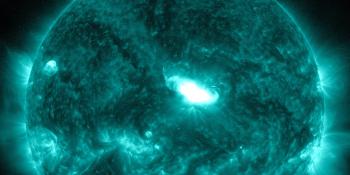Magnetyczna klasyfikacja plam słonecznych
Sunspots come in all sizes and shapes. Some groups of sunspots have a more complex magnetic structure than other sunspot groups and are more likely to produce solar flares. But how do we know if a sunspot group is a threat for strong solar flares? To know the differences, the Mount Wilson observatory in California (USA) made rules so that every sunspot region receives a certain magnetic classification.
Every single day the sunspots on the Sun are counted and every sunspot group receives a number, a magnetic classification and spot classification by the space weather specialists. On our website you can find an overview of all the sunspot groups together with their classifications. Below you will get to know what all of those mean.
Różne klasyfikacje
- α – Alfa:
Jednobiegunowa grupa plam słonecznych. - β – Beta:
Grupa plam słonecznych posiadająca biegunowość dodatnią i ujemną (lub dwubiegunową) z prostym podziałem między biegunami. - γ – Gamma:
A complex region in which the positive and negative polarities are so irregularly distributed that they can't be classified as a bipolar Sunspot group. - β-γ – Beta-Gamma:
A bipolar sunspot group but complex enough so that no line can be drawn between spots of opposite polarity. - δ – Delta:
The umbrae of opposite polarity in a single penumbra. - β-δ – Beta-Delta:
A sunspot group with a general beta magnetic configuration but contains one (or more) delta sunspots. - β-γ-δ – Beta-Gamma-Delta:
A sunspot group with a beta-gamma magnetic configuration but contains one (or more) delta sunspots. - γ-δ – Gamma-Delta
A sunspot group with a gamma magnetic configuration but contains one (or more) delta sunspots.
More than half of the observed sunspot groups receive an Alpha or Beta classification, where bigger sunspots are often more complex and get a Beta, Beta-Gamma or Beta-Gamma-Delta classification. It is well known that delta sunspots can be very active and produce the most intense solar flares.
Klasyfikacja delta
Let's dig a bit deeper into the magnetic delta class. This is the most interesting type of sunspot structure due to the high solar activity which they often cause. With the following list you can determine whether a sunspot has a magnetic delta structure:
- Delta groups are often very big and 90 percent of the sunspots have a reversed polarity with a high activity level, especially when big solar flares erupt. These have mostly a complex, unusual or broken view of the umbra.
- Delta groups are formed by the aggregation of sunspots with opposite polarity of various dipoles, which are linked to shared magnetic field lines rather than direct magnetic lines. All spots are located in the penumbral region.
- Plamy z Deltą rzadko trwają więcej niż jedna rotacja słońca. Rozpadają się szybciej niż inne plamy słoneczne jednakże nowa delta, może się uformować na tym samym obszarze.
- Grupy plam słonecznych typu delta zazwyczaj nie rozdzielają się, lecz giną razem.
- Active delta groups emit strong H-alpha emissions. Sometimes filaments can come out of the group.
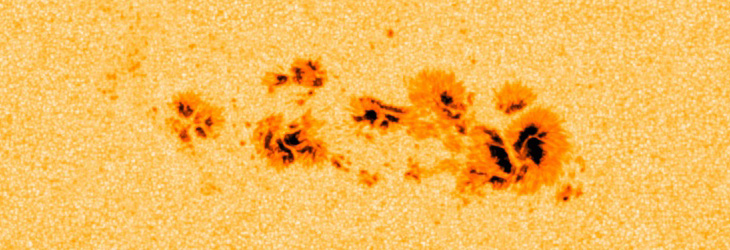
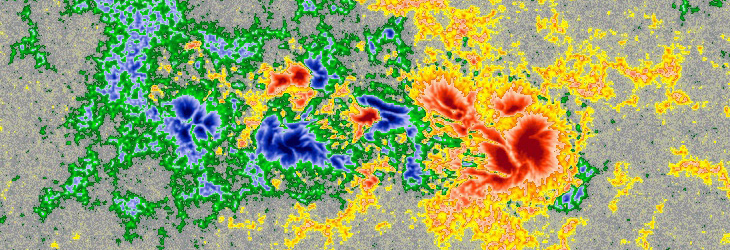
Przykład bardzo skomplikowanego regionu plam słonecznych z klasyfikacją Beta-Gamma-Delta widziany przez instrument NASA SDO's HMI. Ten region plam słonecznych był źródłem niezwykle znaczącego rozbłysku słonecznego X2.3. Obrazek na górze pokazuje tego region plam słonecznych w widzialnym świetle. Obrazek na dole, nazywanym "magnetometrem", ukazuje układ magnetyczny tego regionu. Kolor czerwony reprezentuje obszary lub plamy słoneczne o negatywnej biegunowości a niebieski kolor reprezentuje obszary z pozytywną biegunowością.
Najnowsze wiadomości
Najnowsze wiadomości z forum
Wesprzyj SpaceWeatherLive.com!
Wielu ludzi odwiedza SpaceWeatherLive aby śledzić aktywność słoneczną lub sprawdzić czy jest szansa na zaobserwowanie zorzy polarnej. Niestety, większy ruch na stronie oznacza większe koszty utrzymania serwera. Dlatego, jeśli jesteś zadowolony ze strony SpaceWeatherLive, zachęcamy do wspierania nas finansowo. Dzięki temu będziemy mogli utrzymać naszą stronę.

Fakty na temat pogody kosmicznej
| Ostatnie rozbłyski klasy X | 2024/11/06 | X2.39 |
| Ostatnie rozbłyski klasy M | 2024/11/13 | M1.7 |
| Ostatnia burza geomagnetyczna | 2024/11/10 | Kp5+ (G1) |
| Dni bez plam słonecznych | |
|---|---|
| Ostatni dzień bez skazy | 2022/06/08 |
| Średnia miesięczna liczba plam słonecznych | |
|---|---|
| października 2024 | 166.4 +25 |
| listopada 2024 | 170.8 +4.3 |
| Ostatnie 30 dni | 165.1 +20.3 |
